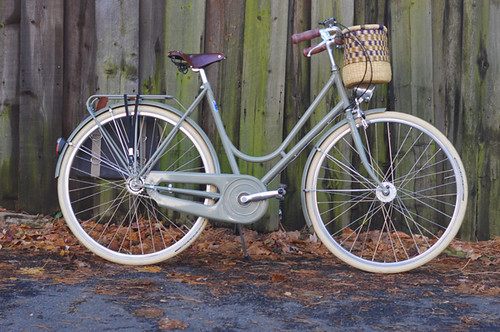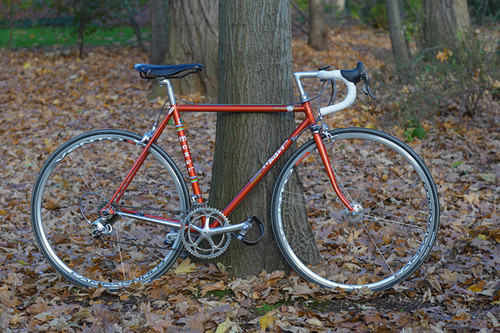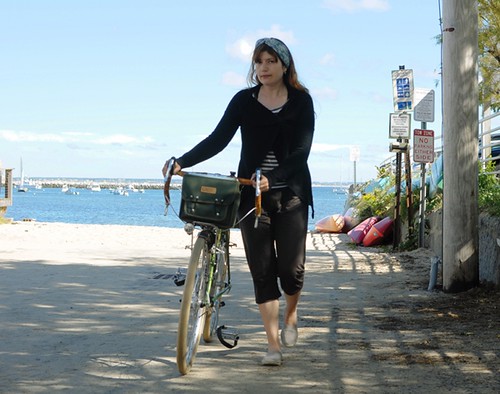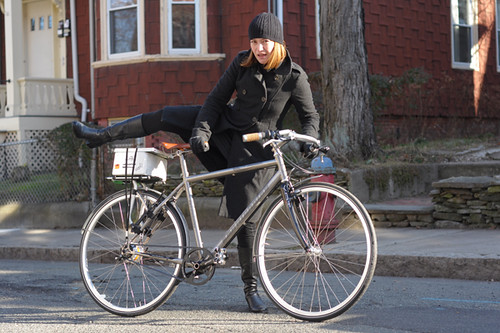
When I write about topics such as cycling clothing, fixed gear, bike handling skills, etc., someone will inevitably chime in to point out that these things are not necessary for "everyday" cycling. This is rather ironic given that my blog started precisely because I felt such things were not necessary for everyday cycling. It is also ironic, because I still very much agree. This here above is a transportation bicycle. It is my "everyday bike" - that is, the bicycle I ride to get around. In a skirt and blouse. In a 3/4 length overcoat. In office shoes. With my laptop bag strapped to the rear rack. It is the exact same type of bicycle I rode for transportation when I first started this blog. My preferences in this regard have not changed over time; they have only solidified.

Now this here is a roadbike. This type of bicycle is designed for sport, and it is meant to go fast over long distances. I love riding this thing. I ride is as fast as I can, because that's the point - to get an intense workout and to see how well I can do. As with other athletic activities (jogging, aerobics, skiing), it is more comfortable and also customary to wear special clothing for roadcycling. That is why on my roadbike I wear padded shorts, a cycling jersey, padded gloves and dorky sunglasses. Sometimes even a helmet. Over time, I have come to enjoy the sport of roadcycling more and more, and while I am not very good at it yet, I hope that some day I might be. I've recently joined a local club. Maybe in a couple of years I can even race. But all of this has as little to do with me as a transportational cyclist, as a newfound interest in running would have with my being a pedestrian.

It is an unfortunate fact that in some countries today, including the US, cycling for sport and cycling for transportation are often confounded. It is also true that when some people get into road cycling, athletic sensibilities end up colouring their view of what transportation cycling should be like as well: They grow impatient with the slower speed of upright bikes, and find it strange to wear everyday clothes on a bicycle at all. For these reasons, I do understand why it makes some nervous when roadcycling topics appear on this blog. Will I eventually be lost to this mentality? I have good reason to believe that no. I am not willing to change the way I dress in order to accommodate the bike, and I cannot ride a roadbike comfortably in my regular clothing. There have been situations where I've ridden diamond frame bikes with drop bars for transportation out of necessity, and I can certainly do it. But inevitably I am miserable, and I long for my upright step-through bike.

Aside from the clothing issue, I just feel safer and more relaxed cycling through traffic in an upright position. And since Icontrol my speedin an urban environment anyhow, my upright bike is more than good enough for me in that respect. Step-through frames have the additional advantage in that they are easy to hop on and off, especially with packages on the rear rack. No matter how nicely a bicycle handles, unless it has a step-through frame I ultimately find it impractical for me in an everyday context. I have very clear ideas at this point of what works for me as a transportation bicycle, and being involved in roadcycling has only made me appreciate the differences between sport and transport more. I have no desire to blend the two activities.When I ride a roadbike, I basically looklike thisand I am not bothered by that in the least. Speed over style, to be sure. But for getting around in everyday life, I want to retain my identity, and I want to feel comfortable in every way.

To me, thinking of roadcycling and transportation cycling as two radically different things just seems like common sense. In Europe I know many people who race for sport, but get around town on a traditional upright bicycle, and this is considered entirely normal.Why even Henry of Workcycles used to race, and still enjoysriding his track bike on the velodromeon a regular basis. Perhaps some day this dichotomy will be better understood in the US as well. Some do believe that road and transportational cycling can overlap, or at least inform each other, and I am not threatened by that point of view. Also, sometimes it's just fun or funny to combine the two: There are, after all, cargo bike races, Brompton races, and no doubt someone out there has held an omafiets race. Steven Fleming of cycle-space wrote a post on how racing for sport and riding a cargo bike for transportation figure into his identity, which I certainly found interesting. Me, I simply see the road vs transportation cycling dichotomy as the 2-wheeled version of walking vs jogging. The more I cycle for transportation, and the more involved I get in roadcycling as a sport, the more I appreciate them as two distinct and separate realms.
No comments:
Post a Comment